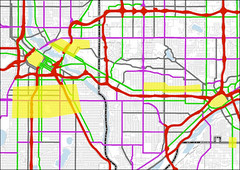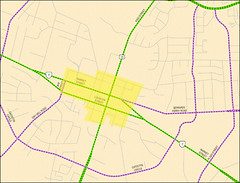Beyond the stimulus: whither communities in the next transportation bill?

Posted February 13, 2009 at 1:35PM
I am immensely grateful to my colleagues at NRDC and in the broader smart growth movement for being on top of what's been going on in the stimulus negotiations, particularly with respect to transportation investment. I know the legislation is better and more transit-supportive than it would have been without their dedication. But that debate has been all about immediate jobs, and bean-counting; it has not been, except in the crudest sense, about policy or the future of the country.
On the big picture, I completely support what the president is trying to do with the stimulus package; this economy is in huge trouble and needs investment NOW. Unfortunately, there has been the usual contingent in Congress that has been pushing tax cuts instead. Um, isn't that what we just tried for the last eight years? How, exactly, does more gasoline put out a fire?
 The discourse over the stimulus details has been painful to watch. It's been "official Washington" at its worst, basically various lobbying interests angling for more money for themselves.
The discourse over the stimulus details has been painful to watch. It's been "official Washington" at its worst, basically various lobbying interests angling for more money for themselves.
That has my friend John Norquist, who used to be mayor of Milwaukee and now heads the Congress for the New Urbanism, concerned. John understands that the stimulus was about money (for transportation, e.g., how much for roads, how much for transit), but he also knows that our policy issues regarding transportation investment are far more complex than that. The next debate, which for these issues will take place in the reauthorization of federal transportation legislation, must take place on a more sophisticated plane.
On Wednesday, John sent me a CNU position paper on how to shape transportation funding so that it supports community, not just modes of travel.  The paper argues for moving away from investment in adding capacity to roadways and toward investment in highly connected street networks, including existing street networks, that support community. Street connectivity is something we've been covering in this blog for a while. While CNU's paper was originally written for the stimulus debate, and the stimulus has not been the right instrument for nuance (gee, ya think?), these ideas deserve a full hearing in the larger transportation debate.
The paper argues for moving away from investment in adding capacity to roadways and toward investment in highly connected street networks, including existing street networks, that support community. Street connectivity is something we've been covering in this blog for a while. While CNU's paper was originally written for the stimulus debate, and the stimulus has not been the right instrument for nuance (gee, ya think?), these ideas deserve a full hearing in the larger transportation debate.
Here's the crux:
"Since existing federal transportation funding focuses to such a great extent on the performance of individual roadways and therefore misses opportunities to capitalize on the benefits of highly connected networks of streets, we propose the following measure be added to [federal legislation]. This measure designates both existing and emerging areas of highly networked streets as areas that are eligible for project funding . . . It recognizes the significant benefits that areas of highly-connected streets arranged in small blocks have in promoting mobility for all users, whether they are walking, bicycling, riding transit or driving automobiles and other motor vehicles.
"These benefits include improved traffic flow based on multiple route choice, shorter trip length, reduced vehicle miles traveled, lower per-capita greenhouse gas emissions and reduced dependence on fossil fuels . . ."
Some would argue, no doubt, that street networks should be funded only locally, not federally. But why? Federal funds support freeways that go through cities (often doing damage to local neighborhoods). Federal funds support local affordable housing and, in some cases, education. Federal funds support local wastewater infrastructure. So why not support the building or repair of street networks that can help existing communities remain strong or recover from decades of neglect, displacing the need for more infrastructure in the land of sprawl?
The paper continues:
"We propose a new system of designations that would apply a "network" label over an entire area, such as a Central Business District or even a small Main Street with its nearby and networked streets. All streets within the network areas would qualify for Federal funding. Street additions that bring an area up the threshold for networked areas would also be eligible for federal funding. The State, Metropolitan Planning Organization or City would set up a system of applying the designations to qualifying areas. Figure 1 [above left] depicts Minneapolis and St. Paul with potential designated network areas shaded in yellow. Figure 2 [above right] depicts how this same designation could work in a smaller scale town, Leesburg, Virginia."
The paper proffers technical standards for qualifying areas (based on the ones we use in LEED-ND) and possible categories of improvements that would be eligible for funding, including many that contribute to "complete streets" suitable for all types of users.
There's a lot more in the document, of course, but I love the idea that transportation dollars could go to support communities and make them stronger and work better. We will continue to need money for transit projects, and more of it - I know John agrees that it is hugely important - but we also can't let our enthusiasm for transit dollars blind us to other great ideas that involve transportation and can make our communities better. Supporting community street networks is one of those great ideas.

